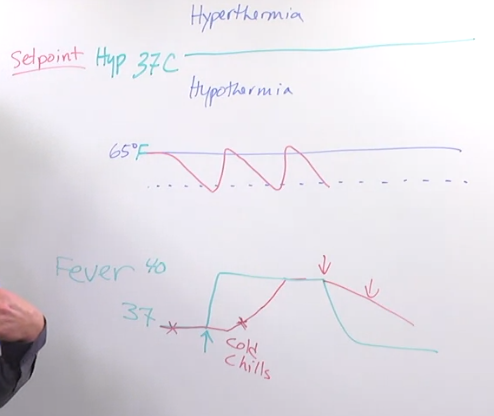- Purpose of thermoregulation: Maintaining brain temperature at 37°C (98.6°F).
- Effector mechanisms:
- Heat production: metabolism and skeletal muscle contraction.
- Heat conservation: behavioral (huddling, reducing body surface area), anatomic (vasomotion).
- Heat loss: behavioral (splaying out, sweating, panting), anatomic (vasomotion).
Heat Conservation and Loss
- Vasomotion:
- Heat conservation: Constriction of blood vessels in the skin to reduce heat loss.
- Heat loss: Dilation of blood vessels in the skin to increase heat loss.
- Paradoxical vasodilation: Dilation of blood vessels in extremely cold conditions to prevent skin freezing (frostbite).
- Sweating: Evaporation of sweat cools the body, but is ineffective in high humidity conditions.
- Lack of cooling mechanisms: Humans lack the ability to actively cool down, making heatwaves dangerous.
Key Points
- Mammals are unique in their ability to produce heat through metabolism.
- Vasomotion is a crucial mechanism for both heat conservation and loss.
- Sweating is the primary method of cooling the body, but it has limitations.
- Heatwaves pose a significant health risk due to the body’s inability to effectively cool down. Hyperthermia
Thermoregulation

- Comparison of body thermoregulation to a thermostat: Both maintain a desired temperature. However, the body’s system is more complex and precise.
- Hypothalamus: The brain’s control center for temperature regulation. Maintains a rock-steady temperature (37°C or 98.6°F) regardless of external conditions.
Set Point and Thermoregulation
- Set point: The desired body temperature, maintained by the hypothalamus.
- Sensors: The body uses various sensors (e.g., skin, internal organs) to monitor temperature.
- Feedback system: The body makes adjustments (e.g., vasoconstriction, sweating) to maintain the set point.
- Hyperthermia: Body temperature above the set point.
- Hypothermia: Body temperature below the set point.
Fever
- Fever: A condition where the set point is elevated due to a pyrogen (fever-inducing substance).
- Symptoms: Chills, feeling cold due to the new, higher set point.
- Antipyretics: Medications that lower the set point, leading to sweating as the body cools down.
- Potential benefits: Some evidence suggests fever enhances immune function.
Thermoregulation in Menopause
- Vasomotor disorders: Hot flashes and night sweats experienced by many menopausal women.
- Disrupted thermoregulation: Difficulty maintaining a stable body temperature.
- Thermo-neutral zone: The range of temperatures where the body doesn’t need to actively regulate. This zone is significantly reduced or nonexistent in menopausal women.
- Cycle of discomfort: Small temperature fluctuations can trigger hot flashes or chills, leading to a cycle of discomfort.
- Strategy: Staying slightly cool to avoid triggering hot flashes.
Conclusion
- The body’s thermoregulation system is complex and vital for maintaining health.
- Conditions like fever and menopause can disrupt this system, leading to discomfort.
- Understanding thermoregulation can help individuals manage these challenges.